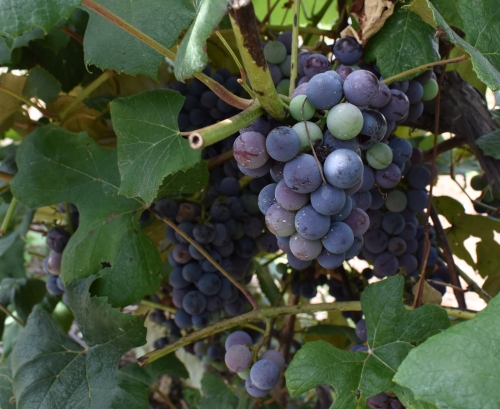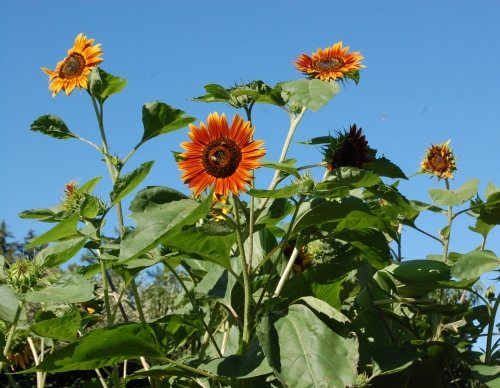Franciscan Foundations
St. Francis Re-creates the Scene of Christ’s Birth
In his biography of St. Francis, St. Bonaventure tells the story of Francis at Greccio on Christmas Eve in 1223:
It happened, three years prior to his death, that he decided to celebrate at the town of Greccio the memory of the birth of the Child Jesus with the greatest possible solemnity, in order to arouse devotion. So that this would not be considered a type of novelty, he petitioned for and obtained permission from the Supreme Pontiff.
He had a manger prepared, hay carried in and an ox and an ass led to the spot. The brethren are summoned, the people arrive, the forest amplifies with their cries, and that venerable night is rendered brilliant and solemn by a multitude of bright lights and by resonant and harmonious hymns of praise. The man of God stands before the manger, filled with piety, bathed in tears, and overcome with joy. A solemn Mass is celebrated over the manger, with Francis, a levite of Christ, chanting the holy Gospel. Then he preaches to the people standing around him about the birth of the poor King, whom, whenever he means to call him, he called in his tender love, the Babe from Bethlehem. A certain virtuous and truthful knight, Sir John of Greccio, who had abandoned worldly military activity out of love of Christ and had become an intimate friend of the man of God, claimed that he saw a beautiful little child asleep in that manger whom the blessed father Francis embraced in both of his arms and seemed to wake it from sleep (The Major Life of St. Francis, Ch. 10, Vol. 2, p. 610).
It is said that St. Francis’ reenactment of the birth of Christ at Greccio in 1223 was so “real” that those present could hear sheep bleating around the manger, and that John of Greccio saw what had begun as a lifeless image of the Child Jesus become the living Christ Child in Francis’ arms. Afterward, it was reported that sick animals fed pieces of straw from the living creche were restored to health and that women in labor who were touched with the straw had healthy, safe deliveries (Augustine Thompson, St. Francis of Assisi: A New Biography, 2018, p. 108-109).
This story exemplifies the theme of incarnational or sacramental ecology that is at the heart of Franciscan spirituality. This theme derives from the Catholic teaching that “the fundamental reality from which all sacramentality ultimately derives is the incarnate Son of God” (Paul McPartland, “Catholic Perspectives on Sacramentality,” 2008, p. 221). By reenacting the birth of the Christ-child physically in the living crèche at Greccio, St. Francis called forth, through an outpouring of grace, the spiritual reality of the Incarnation of God in Christ.
 The notion of sacramental ecology as presented in these modules flows out of this experiential approach and the conviction that, because God created the world and became incarnate in Christ, the material world contains, as it were, the imprint of God. The world cannot be divorced from God and is one complex reality that is both physical and spiritual. Hands-on experiences with nature can thus open persons to a spiritual dimension, through their contact with the physical world. For Catholics, care of creation should be a means of not only protecting and preserving nature, but also a vehicle for cultivating a deeper relationship with God.
The notion of sacramental ecology as presented in these modules flows out of this experiential approach and the conviction that, because God created the world and became incarnate in Christ, the material world contains, as it were, the imprint of God. The world cannot be divorced from God and is one complex reality that is both physical and spiritual. Hands-on experiences with nature can thus open persons to a spiritual dimension, through their contact with the physical world. For Catholics, care of creation should be a means of not only protecting and preserving nature, but also a vehicle for cultivating a deeper relationship with God.
Creation as a Sign Pointing to the Creator
The Catholic notion that the sacraments are both reality and sign undergirds the notion of sacramental ecology in these modules. This means that, while concrete matter is real, understandable and good in itself, it is also imbued with God’s hidden presence and so is a sign pointing beyond itself to the Creator. Simply put, that which is sacramental is real in itself and yet at the same time points beyond itself. This reciprocal relationship endows the material world with a kind of sacrality that should buttress our faith in, and care of, creation as Catholics.
In the Franciscan sacramental understanding, the natural world is an entrance point to the spiritual world and continually reveals the incarnate God. The role of humans is to train their ears to listen to the message of each creature in creation and to open their eyes and hearts to perceive the sign, or the revelation of the divine, that the beauty and complexity of the created world is communicating. The goal of the experiential activities in these modules is to facilitate this Franciscan process of cultivating sacramental relationships with the created world – taking our relationship with reality seriously, while at the same time being open to what the reality reveals about the incarnate God.
Laudato Si’ Connections
Importance of “The Real”
The theme of sacramental/incarnational ecology is a response to a number of crises in the culture and the Church at this time. At the root of the current educational crisis, according to the Vatican Compact on Education, is a “dearth of interiority” that has grown out of a consumeristic, throw-away culture which has fragmented persons and held them back from being able to reflect on the deeper meaning of reality and experiences. Other trenchant analyses have noted that post-modernist culture, due to the rise of the “technocratic paradigm” (as Pope Francis calls it in Laudato Si’), is blurring the boundaries between the real and the virtual and causing persons to lose a sense of reality. Furthermore, Pope Francis has repeatedly emphasized the importance of reality throughout his pontificate. “Reality,” he says, “is more important than ideas,” for as sacramental people, we need to “incarnate the word and put it into practice” (Evangelium Gaudium, §§231-233). It is thus important to renew educational efforts to reconnect persons with see-touch realities, to encourage them to interiorize and reflect on their experiences of reality, and to act out of a deep sense of interiority.
Belief in the Real Presence
 Another contemporary crisis, one particularly affecting the Catholic Church, is a sacramental crisis. Disaffiliation from the Church is at an all-time high, and polling data shows that many Catholics do not understand or believe in the sacramental nature of the Eucharist. For example, a PEW study in 2019 revealed that only about one-third (31%) of U.S. Catholics believe in the real presence of Jesus in the Eucharist. Further, close to one-half of Catholics (43%) misunderstand the Church’s teaching on transubstantiation and believe that the Church teaches that the bread and wine are only symbols. In response to this sacramental crisis, the United States Bishops have called for a three-year grassroots revival of devotion and belief in the Real Presence of Jesus in the Eucharist (https://eucharisticrevival.org/). Bishop Cozzens, organizer of the Eucharistic Revival, says that the root of the crisis is “the loss of a sacramental worldview” and that as a result, people struggle to understand the sacraments as “God’s very life being communicated through physical, tangible reality” (https://www.catholicnewsagency.com/news/251019/bishop-cozzens-talks-new-eucharist-film-explores-disbelief-in-the-real-presence).
Another contemporary crisis, one particularly affecting the Catholic Church, is a sacramental crisis. Disaffiliation from the Church is at an all-time high, and polling data shows that many Catholics do not understand or believe in the sacramental nature of the Eucharist. For example, a PEW study in 2019 revealed that only about one-third (31%) of U.S. Catholics believe in the real presence of Jesus in the Eucharist. Further, close to one-half of Catholics (43%) misunderstand the Church’s teaching on transubstantiation and believe that the Church teaches that the bread and wine are only symbols. In response to this sacramental crisis, the United States Bishops have called for a three-year grassroots revival of devotion and belief in the Real Presence of Jesus in the Eucharist (https://eucharisticrevival.org/). Bishop Cozzens, organizer of the Eucharistic Revival, says that the root of the crisis is “the loss of a sacramental worldview” and that as a result, people struggle to understand the sacraments as “God’s very life being communicated through physical, tangible reality” (https://www.catholicnewsagency.com/news/251019/bishop-cozzens-talks-new-eucharist-film-explores-disbelief-in-the-real-presence).
The notion of sacramental ecology is one avenue of response to these dual crises of reality and faith, for land-based experiences of sacramental ecology using the approaches outlined in these educational modules can be a vehicle for restoring a sacramental worldview; they can be a preparation or first step toward entering more deeply into the sacramental life of the Church. Once persons are taught about sacramentality through hands-on land experiences, they may be more open, over time, to being led into an understanding of particular physical realities as communicating God’s life.
“Listening” to the Message of Each Creature
As Pope Francis writes in Laudato Si’, each creature communicates its goodness to us and speaks a message from God:
The entire material universe speaks of God’s love, his boundless affection for us. Soil, water, mountains: everything is, as it were, a caress of God. . . God has written a precious book, ‘whose letters are the multitude of created things present in the universe.’ The Canadian bishops rightly pointed out that no creature is excluded from this manifestation of God: ‘From panoramic vistas to the tiniest living form, nature is a constant source of wonder and awe. It is also a continuing revelation of the divine’ (LS §§84-85).
 Each creature, possessing an intrinsic goodness and purpose in the created world, is constantly manifesting God. It is the role of humans to understand and appreciate that goodness and purpose and to listen to the “message of each creature in the harmony of creation” (LS §§84-85). No other creature has the capacity to do this other than humans. Laudato Si’ emphasizes that through experiences of creation that encourage contemplation, humans can “discover in each thing a teaching which God wishes to hand on to us” (LS §85). Moving from the physical to the spiritual, from experiences of the exterior to the interior world, is a uniquely Franciscan journey that helps persons to see God in all things (LS §233). Thus, the spiritual journey does not involve rejecting matter in favor of a higher spiritual realm, but rather calls for persons to embrace matter sacramentally, because all creatures find their ultimate meaning in Christ, who “has incorporated in his person part of the material world, planting in it a seed of definitive transformation” (LS §235). It is this kind of sacramental embrace of creation that is at the heart of the kind of ecological conversion called for in Laudato Si’. Ultimately, this process of conversion through relating to creation sacramentally could be instrumental in leading persons to deeper Eucharistic faith.
Each creature, possessing an intrinsic goodness and purpose in the created world, is constantly manifesting God. It is the role of humans to understand and appreciate that goodness and purpose and to listen to the “message of each creature in the harmony of creation” (LS §§84-85). No other creature has the capacity to do this other than humans. Laudato Si’ emphasizes that through experiences of creation that encourage contemplation, humans can “discover in each thing a teaching which God wishes to hand on to us” (LS §85). Moving from the physical to the spiritual, from experiences of the exterior to the interior world, is a uniquely Franciscan journey that helps persons to see God in all things (LS §233). Thus, the spiritual journey does not involve rejecting matter in favor of a higher spiritual realm, but rather calls for persons to embrace matter sacramentally, because all creatures find their ultimate meaning in Christ, who “has incorporated in his person part of the material world, planting in it a seed of definitive transformation” (LS §235). It is this kind of sacramental embrace of creation that is at the heart of the kind of ecological conversion called for in Laudato Si’. Ultimately, this process of conversion through relating to creation sacramentally could be instrumental in leading persons to deeper Eucharistic faith.
Msgr. James Shea summarizes the dynamic of sacramentality well when he writes:
In order for the unseen, spiritual world to become a living force in our minds, this invisible world needs to be visibly incarnated in space and time. This principle touches on the sacramental nature of things, the intercommunion between the material and the spiritual, and can be seen in the way God has revealed himself from the beginning. In showing himself to be the creator…he did not merely get these ideas going esoterically in peoples’ minds. He fashioned these invisible truths into visible forms that would be reminders of them and roads to experiencing them (James Shea, From Christendom to Apostolic Mission, p. 48).
Particular Accent of FSE Spirituality
Connecting with Spiritual Realities through Analogies

“In the winter he [St. Francis] had honey or the best wine put out for the bees so that they would not perish from the cold. He used to extol the artistry of their work and their remarkable ingenuity, giving glory to the Lord.” -The Life of Saint Francis by Thomas of Celano, Francis of Assisi: Early Documents, vol 1, 250
Supplemental References
- Pope Francis, Laudato Si’ (2015), available at https://www.vatican.va/content/francesco/en/encyclicals/documents/papa-francesco_20150524_enciclica-laudato-si.html.
- Pope Francis, Evangelium Gaudium (2013), available at https://www.vatican.va/content/dam/francesco/pdf/apost_exhortations/documents/papa-francesco_esortazione-ap_20131124_evangelii-gaudium_en.pdf.
- Bonaventure, The Major Legend of St. Francis, available at https://franciscantradition.org/francis-of-assisi-early-documents/the-founder/the-legends-and-sermons-about-saint-francis-by-bonaventure-of-bagnoregio/the-major-legend-of-saint-francis/the-life-of-blessed-francis/1699-fa-ed-2-page-610#ges:searchword%3Dgreccio%26searchphrase%3Dall%26page%3D1.
- Catechism of the Catholic Church, §§1667-1679.
- Bishop Cozzens, quoted in Catholic News Agency article by Joe Bukuras, April 20, 2022, https://www.catholicnewsagency.com/news/251019/bishop-cozzens-talks-new-eucharist-film-explores-disbelief-in-the-real-presence.
- Global Compact on Education, Instrumentum Laboris, Vatican https://www.educationglobalcompact.org/resources/Risorse/instrumentum-laboris-en.pdf, https://www.educationglobalcompact.org/en/.
- International Theological Commission, “The Reciprocity between Faith and Sacraments in the Sacramental Economy,” available at https://www.vatican.va/roman_curia/congregations/cfaith/cti_documents/rc_cti_20200303_reciprocita-fede-sacramenti_en.html.
- Kevin Irwin, Chapter 3 on Sacramentality, in Context and Text: A Method for Liturgical Theology (2018), pp. 99-135.
- Paul McPartland, “Catholic Perspectives on Sacramentality,” Studia Liturgica: An International Ecumenical Review for Liturgical Research and Renewal, Vol. 38, No. 2 (2008).
- Kenan Osborne, Sacramental Theology: A General Introduction (1998).
- PEW Research Center survey, February 4-19, 2019, American Trends Panel, released August 5, 2019, https://www.pewresearch.org/fact-tank/2019/08/05/transubstantiation-eucharist-u-s-catholics/.
- Holmes Rolston, “Kenosis and Nature,” in John Polkinghorne, ed. The Work of Love: Creation as Kenosis (Grand Rapids, MI: Eerdmans Publishing Company, 2001), pp 43-65.
- Holmes Rolston, “The Pasqueflower,” Natural History 88, No. 4 (April 1979: 6-16).
- Monsignor James Shea, From Christendom to Apostolic Mission: Pastoral Strategies for an Apostolic Age (2020).
- Augustine Thompson, Francis of Assisi: A New Biography (2012).
- USCCB, The National Eucharistic Revival, available at https://www.eucharisticrevival.org/.




